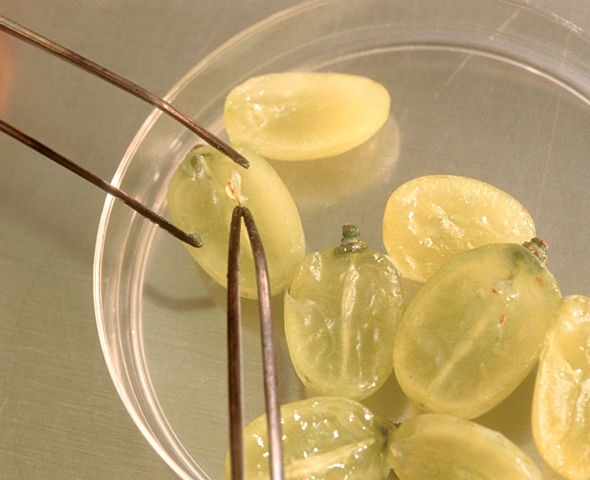Grapes like DOVine, Selma Pete, Sweet Scarlet and Scarlet Royal likely would not exist were it not for ARS scientists’ expertise with a laboratory technique known as “embryo rescue.” The technology “allows us to use two seedless grape plants as parents for new, seedless offspring,” says grape breeder David W. Ramming with USDA Agricultural Research Service (ARS) at Parlier, California.
“Seedless” grapes actually have a small seed inside, “but it’s so small that your tongue can’t detect it,” says Ramming. What’s the point of embryo rescue? To literally rescue the embryo within the minuscule seed so that it can be grown into an experimental vine for testing in the research vineyard.
DOVine, developed by the USDA ARS in 1995, as an early ripening raisin was the first variety released from the hybridization of two seedless grapes using embryo rescue techniques. DOVine resulted from a cross of 79-101 x Fresno Seedless made in 1983. 79-101 is a blue seedless grape of unknown parentage, probably bred by Elmer Snyder of USDA; Fresno Seedless is a sibling of Flame Seedless and resulted from the cross of (Cardinal x Thompson Seedless) x [(Red Malaga x Tifafihi Ahmer) x (Muscat of Alexandria x Thompson Seedless)].
As might be expected, when two seedless grapes are chosen as parents, the seeds inside the grapes of their offspring are also extremely small. Says Ramming, “In nature, those seeds would abort” instead of developing into hard little spheres, each with a healthy embryo inside.
To save otherwise-doomed embryos, Ramming and colleagues excise them with surgical precision from the developing berry (Fig.1). Then, the researchers nurture the embryos on a gel-like bed of nutrients until they form seedlings hardy enough to transplant.
Ramming pioneered the use of embryo rescue several decades ago to breed superb seedless grapes. Today, it still remains the survival secret of many of the team’s most innovative grapes and used by private breeding programs.
